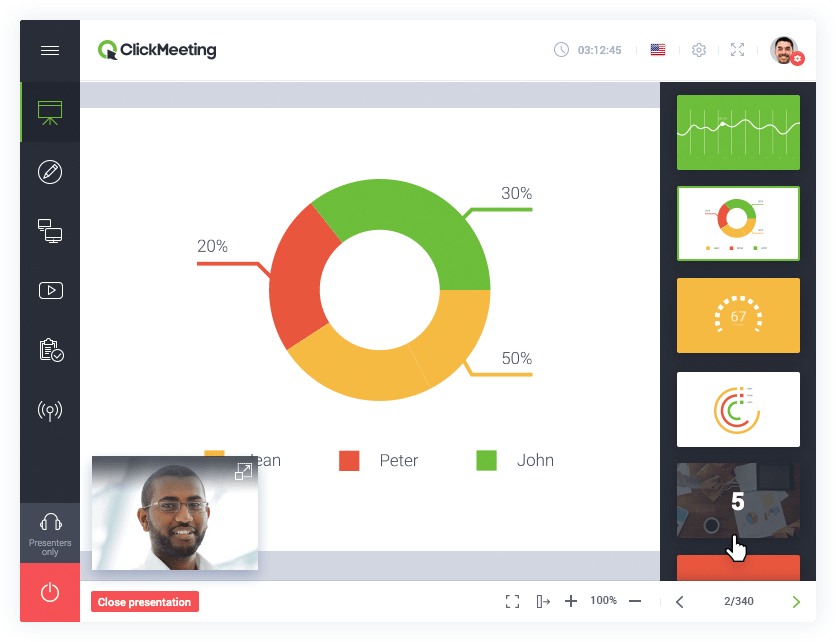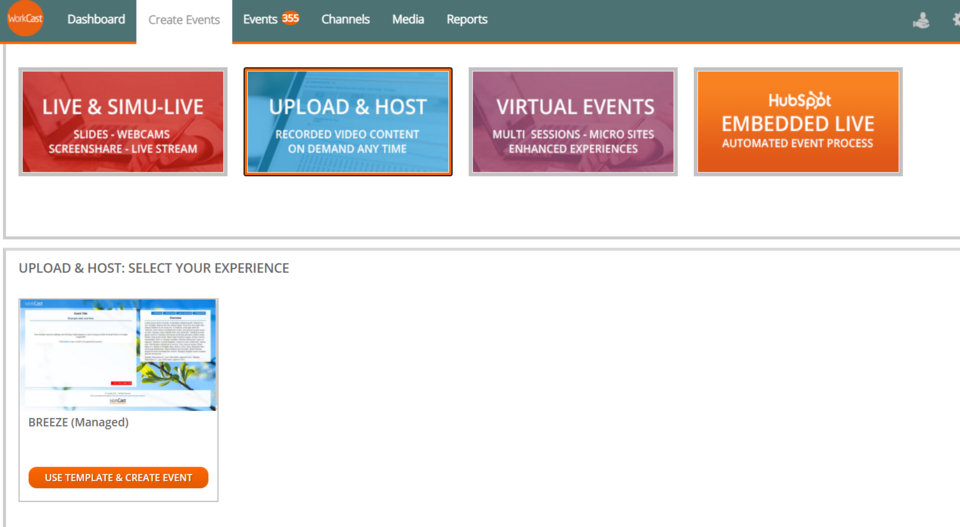
What's Webcasting and How to Use It?
There are few people who haven't participated in at least one webinar, webcasting or online conference. Such remote events are appreciated by both entrepreneurs and consumers. While many of us prefer face-to-face meetings, it's very likely that the popularity of online business sessions won’t decline in the near future. Find out how webcasting differs from other forms of remote meetings and how to use this type of broadcast in your business.
What is webcasting?
Webcasting - like a webinar and online conference - is a type of video broadcast on the Internet. Such an event may be live or pre-recorded. The latter approach allows the creator to develop the material to make it more attractive. Digital customers have high expectations of the level of external communication of companies. Extra time for fine-tuning the webcasting allows organisations to produce high-quality videos.
This form of delivery usually doesn't give much opportunity for interaction with the audience, as it’s the one-way form of communication. Thanks to it, the speaker can reach a very large group of recipients and efficiently convey their message. However, providers of individual solutions sometimes deviate from this principle by sharing various cooperation tools or tests to check knowledge.
Webinar, online conference, webcasting - differences
All three forms of Internet broadcasts allow you to carefully build an online community around your brand and to engage and activate your current or potential customers. You can treat each of them as a tool to achieve specific marketing goals. Here are some differences between an online conference, a webinar, and webcasting.
Online conference
Companies usually organise conferences to gather in one place an audience interested in a specific topic (e.g. promotion in social media, solutions for cybersecurity, specific technologies, etc.). An example of such an event is DrupalCamp Poland, where people who want to deepen their knowledge about Drupal meet.
During the conference people from all over the world gather on the online meeting platform. Usually, many speakers - specialists in a specific field - participate. Their job is to relate to the main topic of the conference by presenting their opinion or knowledge. The time for a single speech is limited.
It's a one-way form of communication. The speakers address an audience that can only listen. Occasionally, during the conference the platform can host a chat accessible to all participants.
Webinar
Also, many people meet during a webinar, but only a few speakers speak, and very often only a single person speaks to many listeners. Unlike webcasting and online conferencing, all participants (presenters and listeners) can interact with each other during a webinar. The people invited to listen can ask questions using a microphone, share their screen, and chat. In addition, the platforms for organizing webinars allow you to create virtual rooms which the users can switch between and conduct discussions or collaborate on a virtual board. The organizer can also create tests and polls for the listeners.
The main advantage of a webinar is that the listeners can immediately ask a question and get an answer to it. It's worth choosing a webinar when the event is focused on constant interaction with the audience.
Webcasting
Webcasting is more akin to a television broadcast than online meetings. It's an example of one-way communication, even more so than an online conference where chat is sometimes available, allowing the participants to say hello and ask the speakers questions. Although webcasting can be live, it's often prepared very carefully in advance using modern multimedia tools. Not only is the content thought out, but also the way it's presented, and the scenery.
During webcasting, usually a single person addresses many. Whether webcasting is live or not, there is no information exchange between viewers or real-time communication between the speaker and listeners. The recipients aren't provided with any collaboration tools or knowledge-checking tests.
Webcasting is often used in both business and education. Could this form of broadcast be better than a webinar or an online conference?
When should you use webcasting in business?
Creating webcasting makes sense when you want to reach the largest possible audience, but you don't need the audience to actively participate in the event by commenting or asking questions. In some situations, it's advisable to exclude the ability of asking questions – in particular when the speech may be available for a limited time or when you plan to redistribute this content to other users in the future.
Webcasting will be great if you want to inform a wide audience about changes in your company, job recruitment, a competition, new project or the company's success. This way you can also present a new product or service. This form of broadcast is suitable for internal (with company employees) and external (with clients, partners and other listeners) communication.
You can also use a webcasting platform to provide access to a specialist panel or conference (e.g. to an excerpt where your employee is present) that you want to show to an audience unable to attend live (due to high participation costs or limited number of participants).
Webcasting is also suitable for tutorials or training courses. Imagine that you're introducing a new solution or selling an innovative product in your business application. Its operation isn't very complicated, but you know that all new things always cause a problem for some users, so you record a short "step by step" tutorial to clearly explain how to use your product. This way, the customers in doubt can get over the difficulties themselves and watch your broadcast, rather than contacting customer service.
Advantages of using webcasting
- Ability to reach a large number of recipients. By organizing webcasting, you can speak to thousands of viewers. Internet transmissions aren't limited to the physical space where events take place, and the form of webcasting doesn't force the participants to be present at a specific time. You can scale your webcasting depending on the demand for the event, as long as the platform you choose can handle the traffic.
- High quality of communication. Just because the audience cannot interact with the speaker, it doesn't mean that the level of engagement will be low. During and after webcasting, the participant can reach you through your customer application, website or social media profile. Webcasting is a good idea if you want to professionally refine the broadcast, achieving a quality comparable to TV or studio. This way, you improve your image and offer high-quality material to your audience.
- Audience-related statistics. Webcasting platforms allow you to see who was at your event, for how long, what content they were interested in - so you can better plan presentations and other marketing activities in the future.
- Availability. Many people may not be able to attend live events in person due to work, school or other commitments. Webcasting allows you to share the event with anyone and at any time.
Webcasting software - examples
Often, online event platform providers give the users access to the tools for conducting remote conferences, webinars, and webcasting within a single platform. Below you'll find examples of three platforms suitable for hosting webcasting.
ClickMeeting
ClickMeeting is a mobile-friendly web platform, which ensures convenience for both listeners and speakers. Business users can test it during the 30-day free trial period. Integration with other tools and automation is also possible.

Source: ClickMeeting
The tool allows you to organize large-scale online events. You can invite up to 10 thousand viewers to your webcasting. It’s also possible to divide the event into smaller groups. Thanks to the payment integration, you can sell tickets for each session via PayPal or PayU, or integrate the platform with your own system.
A maximum of four people can participate in a discussion panel. During webcasting, the instructor can display a presentation, documents, films, as well as draw on a virtual board. As the organizer, you can also create a participation certificate for the people taking part in the webcasting.
BigMarker
BigMarker is a paid platform for organizing any type of online meetings. You can use it to plan and conduct a virtual conference, webinar and webcasting. The tool has a lot of interesting functionalities, e.g. the ability to personalize the video player. You can choose your brand symbols such as logos or company colours.
As the platform allows you to create not only webcasting, you can add interactive elements to your events, such as forms for potential customers or quick surveys. Participants don't need to download any additional software to view or interact with these items. BigMarker also allows you to stream videos, slides, movies, and screen shares to Facebook and YouTube Live. You have special tools to modify your webcasting (by changing the sizes of the items used or adding subtitles) at your disposal.
You can integrate BigMarker with many other platforms, e.g. CRM systems, marketing automation tools, analytical tools, payments, etc.
WorkCast
WorkCast is a cloud-based software for webcasts (SaaS). You don't need to download any plugins. With it, you can efficiently broadcast your events live, regardless of where you are and what device you use. You can use a free trial period of 14 days. There are several payment models, and you can also bill for a single use (organization of an event).
With this solution, you can also use the logo and company colours to personalize the video player. It's possible to add interactive elements so you can increase the engagement of your audience. Integrating WorkCast with marketing automation tools will greatly facilitate the daily work of your marketers and communication with potential recipients.

Source: WorkCast
WorkCast allows you to conduct webcasting for up to 50 thousand users. You also get access to the data about your recipients and their activity in real time.
Summary
Choosing a good platform for hosting online events is extremely important. The right tool will improve the quality of your communication with your audience, while the wrong tool can negatively affect your image. We have listed some interesting solutions for business, but you'll find many more on the market. You can also invest in creating a personalized platform.
As an experienced Drupal agency, we offer substantive and technical support in creating websites and business tools. We build IT solutions from scratch and add new functionalities to the existing programs.











